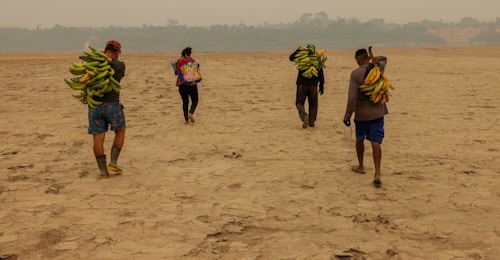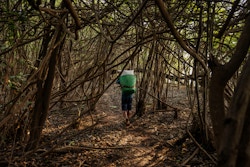
Banana farmers despair as the rivers recede
Part of the series
CLIMATE CHANGE IN THE AMAZON
Text/photo: Vinicius Sassine/Lalo de Almeida
PORTO VELHO, SEPTEMBER 2024: The Madeira River, the largest and most critical tributary of the Amazonas River, has transformed into expansive sandbanks at the height of Porto Velho.
Although the water level ebbs and flows with dry and wet seasons, the river's retreat has come much earlier this year than usual. As a result, farmers must cross vast empty stretches to ensure produce flow.
Madeira has become a silent corridor, devoid of vibration, movement, and much life—in a scenario where there's been no horizon for weeks, shrouded by smoke from fires dominating Rondônia.
On the 3rd of last month, the river reached a record low level in Porto Velho, unprecedented in the historical series that began in 1967.
Measurements compiled by SGB (Brazilian Geological Service) show the river's level at 1.02 m, surpassing the previous record of 1.10 m in 2023, a year of extreme drought in the western Amazon.
About the series:
In the fall of 2024, Rainforest Foundation Norway sent investigative journalist Vinicius Sassine and award-winning photographer Lalo de Almeida to document the human and environmental costs of climate change in the Amazon Rainforest.
The stories were originally published by Brazil's largest broadsheet newspaper, Folha de São Paulo.

Residents of Vila de Itacuã, in Porto Velho, carry banana bunches walking up the bank; transport can no longer be done by boat due to the low level of the Madeira River. Photo: Lalo de Almeida/Folhapress

Now, the drought is even more severe, with the river dryer in the capital region of Rondônia, and lasts longer, reaching historical marks early in September. In 2023, Madeira hit record seasonal lows in October and November.
In 2024, not only is this happening early in September, but amid an absolute absence of rain and uncontrolled fires in Rondônia. The drought still has a long way to go, and the river tends to drop even further.
The alteration of landscapes, sometimes flooding, sometimes drought, is characteristic of the Amazon. Riverside and traditional communities adapt to these cycles. What throws these communities off balance are the extremes, increasingly common, like now, with two severe and successive extreme droughts.
The formation of sandbanks with widths of 1 km and stretching for several kilometers along the river isolates entire communities that rely on banana, cassava, watermelon, and corn cultivation. The drought impacts their way of life as they try to ensure production even without rain, transportation to Porto Velho without a river, and access to potable water even with dry wells.
Folha's reporters visited one such community, Itacuã, located an hour from Porto Velho. The families reside on the other side of the river.

Raimundo Pereira do Nascimento, a resident of Vila de Itacuã, Porto Velho, observes the sand strip formed in Madeira River from his home’s yard. Photo: Lalo de Almeida/Folhapress
In the absence of a drought, the community’s routine involves crossing the river daily on boats to transport banana, watermelon, and corn production to the opposite side of Madeira for dispatch to fairs and markets in the city. Water reaches the community’s port, and a ramp ensures access to the mainland on the other shore.
That scenario no longer exists, and the routine has become far more demanding. The banana bunches are carried on shoulders across the sandbanks to where the boats reach. On the other shore, a cliff climb lies between the community and their destination.





The drying up of the Madeira river has severely disrupted the routines of banana farmers, who now must carry their yields across sandbanks. Photo: Lalo de Almeida/Folhapress
Some residents have left Itacuã to continue their lives on the opposite bank while the drought persists. Those remaining strive to maintain crop production. Stories repeat across various queueing communities. According to the residents, about 500 families face this reality on the Madeira River.
Some farmers who cultivate bananas, especially younger ones, shifted to this activity following the destruction of mining dredges in actions by Ibama (Brazilian Institute of Environment and Renewable Natural Resources) and the PF (Federal Police).
Illegal gold mining on the Madeira River by dredges is recurrent from Rondônia to the southern Amazonas. In just one operation in the Humaitá (AM) region last August, 459 dredges were destroyed. Miners confronted police and set fire to parts of the city to try to stop the action.
Blendo Trindade, 27, used a dredge to mine gold on the Madeira River until 2022, when the vessel was destroyed in a PF operation. "Every miner became a banana planter," he says.
He and his brother, Ricardo Trindade, 26, live in Itacuã and work in banana cultivation. "It's tough because with this drought, the plants are not developing," says Ricardo.
Banana bunches are lost due to transportation difficulties. Itacuã can be accessed from behind, by land, but the road is in terrible condition, and there aren't enough trucks to meet the needs of all communities. Farmers prefer to cross the sandbanks, the stretches of river, and the cliffs to ensure their produce reaches the market.
The price of bananas is low because a portion of what's produced remains trapped, and they are unable to reach other cities due to poor navigation conditions on the river. There's also increased planting and competition, with former miners now working in agriculture.
In pictures: Fire ravages Rondônia





According to farmers, fishing has no longer been a source of income or sustenance since the construction of the Santo Antônio Hydroelectric Plant on the river. The plant—which has halted some of its generating units due to the river's historical low—claims the construction didn't alter the water quality and that conditions for fish species have been preserved.
"The beach wasn't this large back in the day," says Raimundo do Nascimento, 67, who remains with his family in Itacuã to tend to their crops. He grows bananas, watermelon, açaí, oranges, pupunha, and cocoa. "The banana trees aren't thickening the bunches."
Nascimento sees the intense mining exploration as affecting the river's fate. "Mining churned a lot, silted the sandbanks."
The community struggles to access drinking water, which has to be transported from the other bank. Water for bathing or cooking comes from a well. According to residents, the Porto Velho City Hall Civil Defense promised to deliver potable water amid the worsening drought.
According to Civil Defense, There is a lack of water in Itacuã and 21 other communities. The agency announced an emergency purchase of 187,000 liters of mineral water for the communities. This distribution, including water donations from the private sector, is expected to continue until November.







